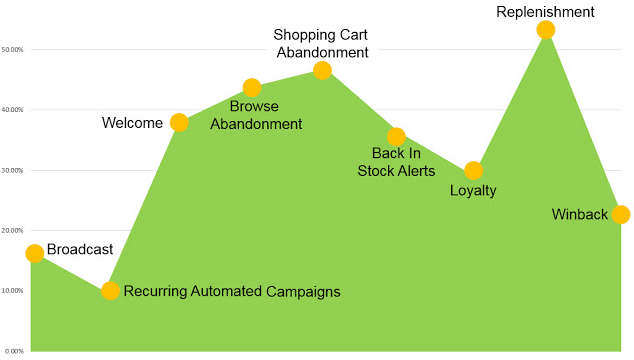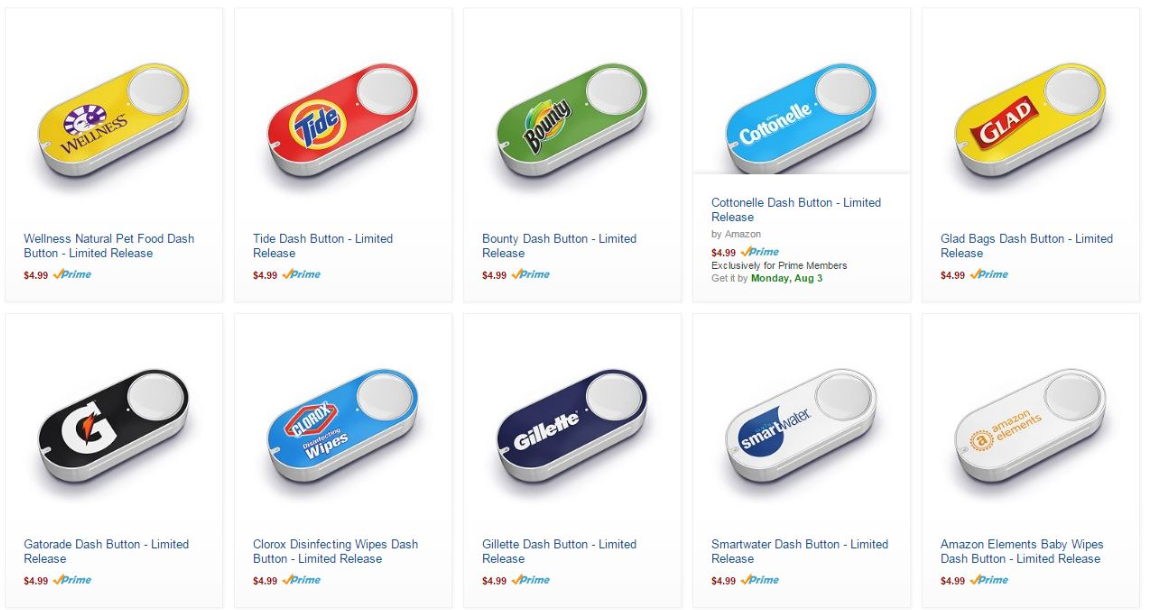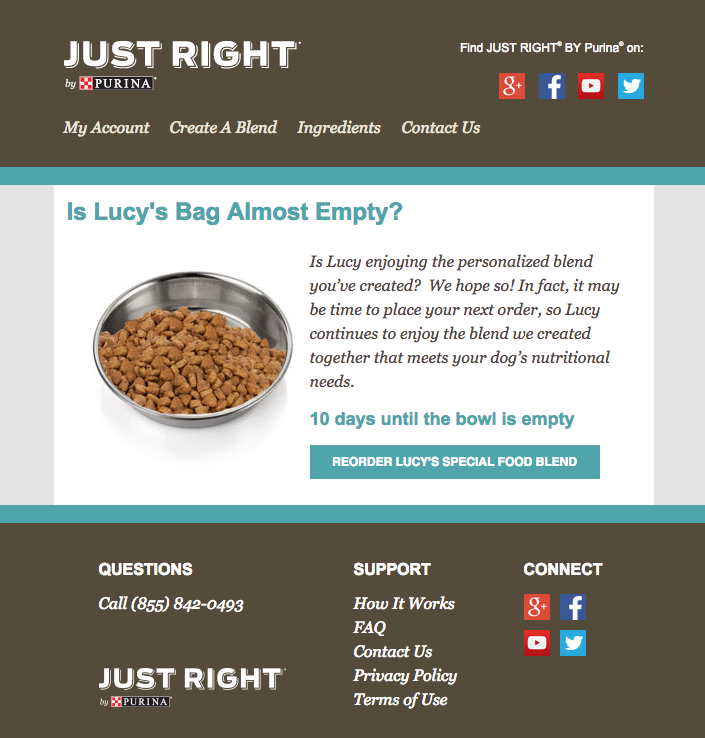How to Use Replenishment Emails to Drive Repeat eCommerce Sales
Whether you’ve been in business for years or are trying to get your first venture off the ground, you probably already know that it’s much easier to sell to an existing customer than it is to attract that customer in the first place.
For ecommerce businesses, this principle is crucially important. In today’s intensely competitive online retail market, merchants need to utilize every tool at their disposal to remain competitive and increase conversion rates. Although there are many ways to accomplish this, one of the most effective—yet often overlooked—strategies for doing so is replenishment emails.
What are replenishment emails, you ask? They’re simple reminder messages to prompt customers to reorder consumable products as they begin to run low. Replenishment emails can be incredibly effective, but most companies don’t even bother to send them. As a result, many companies are literally throwing away opportunities to drive repeat sales of items their customers need and purchase regularly.
Email marketing in general remains a popular and highly effective marketing channel for ecommerce businesses. However, replenishment emails in particular have the highest click-to-open rate of any lifecycle email:

[Source]
So what makes replenishment emails so effective? They’re timely and relevant—a one-two punch that makes them practically irresistible.
Something that makes replenishment emails particularly effective for ecommerce businesses is the fact that customers use consumable products in a predictable, habitual way. In addition, most customers’ consumption habits are relatively static; the amount of coffee a person drinks in a month will most likely remain pretty steady from one month to the next, for example.
The same principle applies to literally thousands of products, from coffee filters and cat litter to toilet paper and toothpaste. When a person begins to run low on an essential everyday item, a timely replenishment email can be a powerful motivator to encourage that customer to buy that item again from you rather than a competitor.
Remember how we said that it was much easier to sell to an existing customer than it is to attract that customer in the first place? Despite this, many businesses—ecommerce businesses in particular—spend significantly more time, money, and effort on attraction rather than retention. They spend thousands of dollars on multichannel ad campaigns but neglect optimizing revenues from the customers they already have.
The other side of this equation is the subscription box, an incredibly popular business model that essentially flips this concept on its head. Rather than devoting almost all their attention to attraction, businesses relying on the subscription model instead allocate most of their resources to customer retention.
“[The subscription model] enables merchants to build a better business from the ground up. Subscription businesses are based on retention versus conversion, which means a better ROI on customer acquisition. They can better forecast the demand for raw materials, essentially solving the inventory problem. As a result, revenue is more predictable. In the end, businesses are smarter and faster.” — Amir Elaguizy, CEO, Cratejoy
Customer retention is rapidly becoming the brave new frontier of conversion rate optimization. However, it isn’t just smaller, agile startups challenging the status quo by focusing more on retention than attraction. Ecommerce behemoth Amazon’s Dash buttons are a direct response to the urgent need for ecommerce businesses to stimulate repeat business.

Obviously, we’re not suggesting that you radically alter your business’ entire model or abandon what you’ve been doing successfully for years in favor of the latest trend du jour. That said, customer retention has never been more important, and replenishment emails are an excellent way to test the waters.
When to Send Replenishment Emails
Operationally, replenishment emails couldn’t be simpler. All you have to do is send reminder emails a certain number of days after customers order specific products.
The trickier part is knowing precisely when to send replenishment emails.
Although most consumers have reasonably predictable needs, there are several variables that can impact how frequently a customer will need a given consumable product:
- The target market of the product, i.e., who uses it
- The average time it takes for the product to run out/break/wear down
- How frequently the customer uses the product
- How your customer actually uses the product
- The customer’s individual purchasing preferences and buying patterns
Even something as seemingly routine as a 30-day supply of coffee isn’t as straightforward a product as it might appear. If the customer drinks more than one cup of coffee every day, or makes an extra pot while entertaining, or dozens of other potential variables, they’ll run out before 30 days have passed.
This means that the real work behind replenishment emails is getting to know your customers intimately and segmenting them into various subgroups based on specific criteria.
For example, to learn more about your customers’ coffee consumption habits, asking them how many cups of coffee they drink per day is a good start. If Customer A only drinks one cup per day, then Customer A’s replenishment email should be sent toward the end of that 30-day period. If Customer B says they drink three cups a day, then Customer B’s replenishment email should be sent around Day 8 or 9 in anticipation of running out on Day 10.
Another factor to consider is purchasing frequency. Although the amount of coffee a customer drinks should be factored into the timing of your replenishment emails, so too should the quantities in which they buy their coffee. A customer who buys two 30-day supplies per order, for example, shouldn’t receive a replenishment email after one month because they still have another month’s supply of coffee in their cupboard.
So how exactly do you go about gathering this vital information? Phone-based customer interviews are a great way to identify and develop the questions you should ask your customers. You may also want to consider sending your customers a quantitative survey to fill in any gaps in the data you’ve gathered in your customer interviews. There are plenty of other ways to collect this information, such as asking follow-up questions in post-purchase emails or on your thank you pages.
It’s important to accept that you’ll probably never be able to time all your replenishment emails perfectly. It’s inevitable that some will miss the mark, and that’s okay. The goal is to spur your customers into action. The closer you can time your replenishment emails to the moment they realize they’re running out, the better.
Make Reordering as Effortless as Possible
Timing your replenishment emails correctly is one thing. Actually getting your customers to reorder is another animal entirely. It’s vital that we remind our customers at the right moment, but we also need to ensure that the actual reordering process is as easy as it possibly can be.
Check out the replenishment email below. Sent by nationwide pet food brand Purina, this replenishment email hits all the right notes.

What’s so great about this replenishment email?
- It’s simple and gets right to the point.
- It cleverly uses the customer’s pet’s name in the copy, reinforcing that personal connection.
- It shows the product itself, which can aid recall.
- It includes a clear indicator of how many days’ supply is remaining, creating a sense of urgency.
- It features a single, crystal-clear call to action.
Everything about your replenishment emails should make it effortless for your customers to reorder. That’s the whole point of replenishment emails—to reduce or eliminate friction in the purchasing process.
Here are some best practices you may want to follow when crafting your replenishment emails.
Fewer Clicks, More Conversions
However you choose to design your replenishment emails, be sure to include a reorder button in the email itself. Don’t redirect customers to a product page, or a promotional landing page, or anywhere else. The more clicks you ask your customers to make during the reorder process, the more opportunities you have to lose them.
Also, don’t ask your customers to manage their own shopping carts when reordering products. Users’ shopping carts should populate with reorder products automatically, and you should also preselect whichever size, quantity, or variant of the product the customer ordered last time.
Essentially, you want to remove as many obstacles between the customer and successfully reordering the product as possible.
Coupons Don’t Cut It
Some retailers try to entice existing customers to reorder products by offering them coupons or other timely discount offers. However, you shouldn’t immediately turn to discounts, especially in the first replenishment email you send to a customer. They’ve already bought from you once and demonstrated an ongoing need for that product, so keep the coupons in your back pocket until you really need them.
A Picture Is Worth a Thousand Words
One of the most effective techniques Purina used in our example replenishment email above was including an image of the dog food the email was encouraging the recipient to reorder.
People respond much more strongly to images than text. Visual cues are often more memorable, which is crucial for replenishment emails. However you do it, be sure to include at least one image of the product somewhere in your replenishment email.
Look for Unexpected Opportunities
So far, we’ve been focused primarily on consumable goods, but there are plenty of opportunities to leverage replenishment emails to drive repeat sales of other products, too.
Plenty of products need replacing on a semi-regular basis. Shoes, tires, apparel, mattresses—these and many other products all have to be replaced at least somewhat frequently, which makes them potential candidates for replenishment email campaigns. Timing your emails for these products might be more difficult than it is for consumables, but the opportunity is there for enterprising ecommerce retailers that want to shift their retention strategies into high gear.
Start Winning Repeat Sales
Considering how effective replenishment emails can be, it’s amazing how few ecommerce businesses take the time to get them right. One of the best things about replenishment campaigns is that they require virtually no ongoing oversight; it really is a “set it and forget it” approach to customer retention that can have amazing results.
However you choose to structure and time your replenishment emails, be sure to remember what really matters—making your customers’ lives easier and helping them buy the things they need effortlessly. They’ll thank you for it later.
Latest posts by David Candelas (see all)
- Use a SMART Goal Template to Hack Your Productivity - December 11, 2020
- Is LinkedIn Worth Your Time as a Salesperson? - November 24, 2020
- Tips for Starting the Home Office of Your Dreams - November 29, 2019

